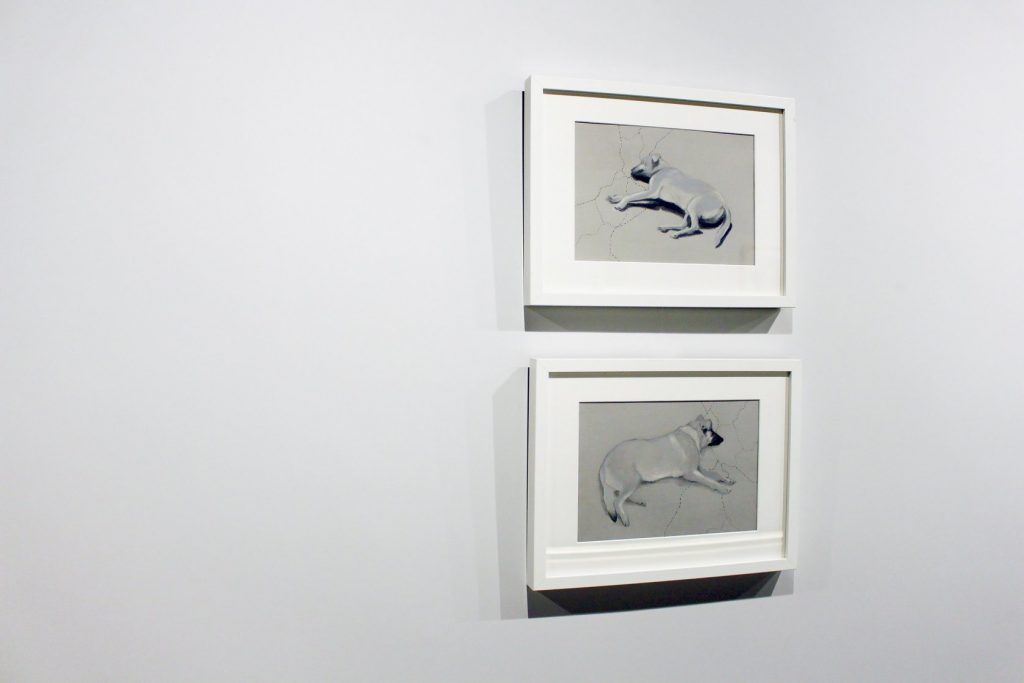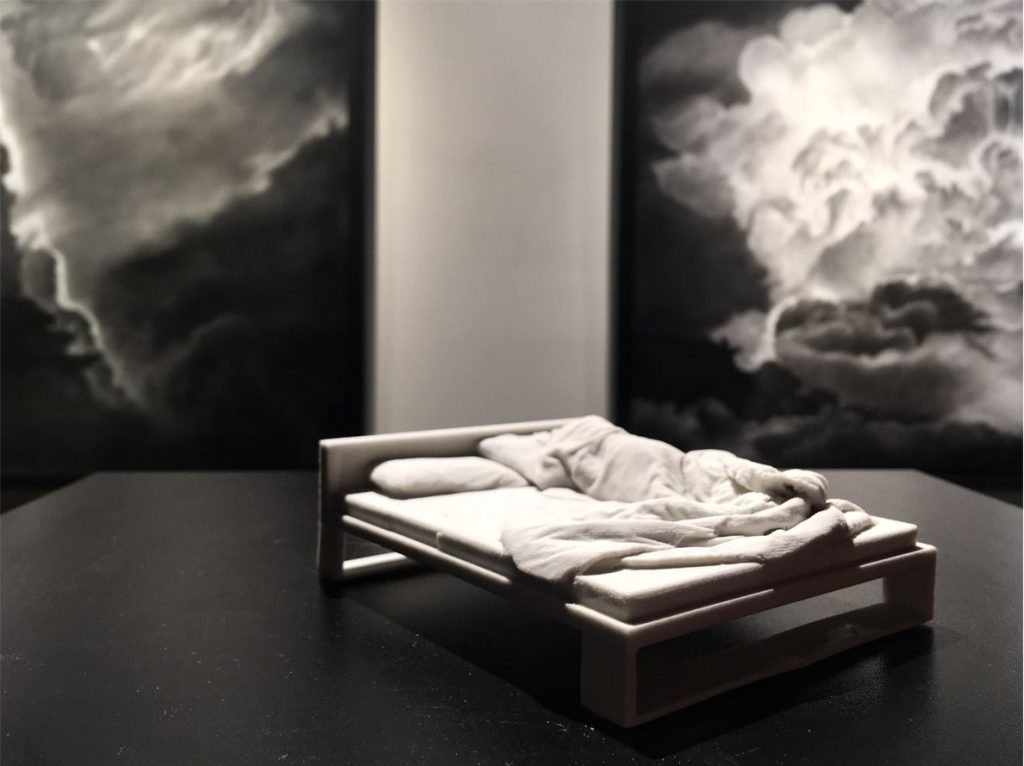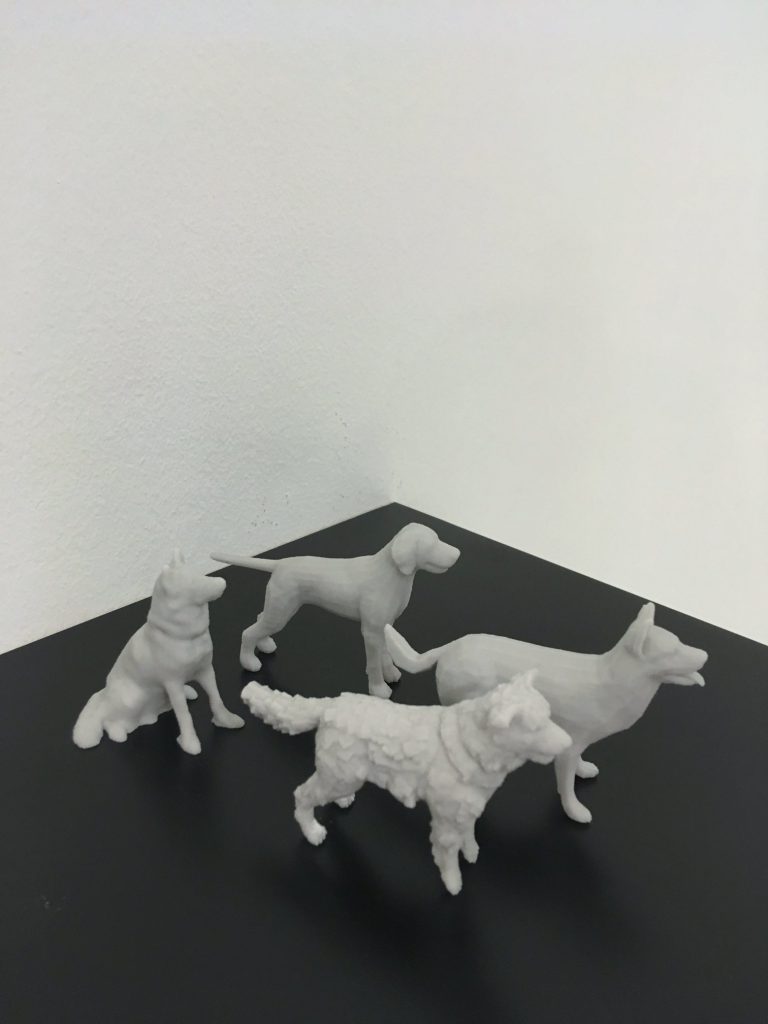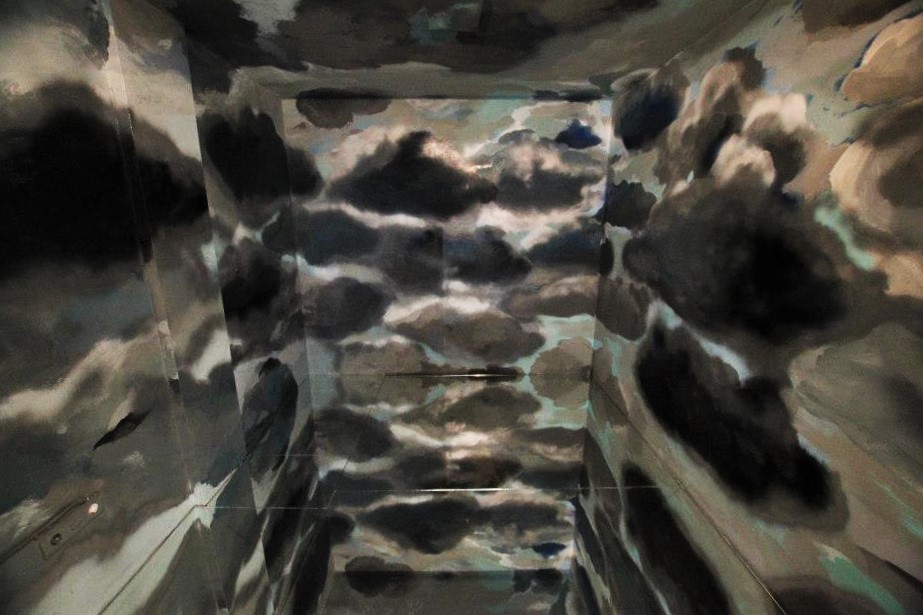While using very different materials and techniques in her art production and creating very detailed works, Aslı Işıksal always prioritizes thinking with pencil and paper. She creates a world for her works where plainness and simplicity are at the forefront. A world that turns into black and white with gray values… While constructing this world, she thinks of her works as a whole where every work establishes strong connections with each other. She emphasizes that surface, layers, figures, and movement are equally important here. She examines images and separates them into layers, freezes, and breaks movement into pieces. All to see the details, explore the pieces, establish a bond between the layers, and finally recombine them to reveal new meanings. First the sound, after the scent, then the wind from the waves and finally the sea…
Interview & Translation: Burçin Nilay Kalınbayrak

I. You work with a wide variety of materials and techniques such as charcoal, oil, acrylic, 3D printing, and wood. In the meantime, while your main discipline is painting, you also produce works in different disciplines such as video, photography, ceramics, and sculpture. Sometimes you cover a single theme in-depth with different materials and techniques through different disciplines. For example, you addressed the sky as a theme in your solo exhibition titled “Blank Earth” at Arte Sanat, Ankara in 2017. How do you decide which materials and techniques to work with? What inspires you when working on different disciplines? Could you tell us about your thought and production processes?
Hi, first of all, thank you for your questions, it was very pleasant for me to answer. While producing art, an artistic issue that you think about and ponder is emerging in a way over the years and it is a very inspiring process trying new materials and unraveling the nature of the materials while tackling this issue. In general, when organizing my solo exhibitions, I like to design the works that will take place in the exhibitions in a way that they form a whole, not one by one. In this way, I believe that the works in the exhibitions establish strong connections with each other. As you said, in my exhibition “Blank Earth”, I aimed to draw a map of the world with sky images. Skies that change, darken, open, and even are exposed to explosions as they move. Each represented different geographies. Therefore, some skies were made of nails and some of thin paper like a tulle. My interest in inherently solid materials such as marble, wood, and stone has increased day by day. Of course, thinking with pen and paper is always my priority.

Aslı Işıksal, (top) “Blank Earth Series 33”, Lightbox installation, 30×35 cm, 2016. (Middle-left) “Blank Earth Series 9”, Nails on wood, 30×35 cm, 2016. (Mİddle-right) “Blank Earth Series 31”, Nails on wood and ecoline, 52x70cm x 4 pieces, 2016. (Bottom) “Blank Earth Series 45”, Ceramics, 12×16 cm, 2016. From the solo exhibition “Blank Earth” at Arte Sanat, Ankara, 17.01-11.02.2017. Photos by Güncel Sanat Arşivi
II. Your 3D printed figures, which we saw for the first time in your solo exhibition titled “Stand By” at Tilki, Ankara in 2016, have become prominent among your recent works. In these works, you usually are the model for the scenes from everyday life. Sometimes you are accompanied by trees, animals, and various objects as in the group exhibition called “Angels’ Share” at Depo Istanbul in 2017; at Mamut Art Project in 2018; and also in the exhibition curated by “Benden Güçlü (Stronger Than I Am)” art collective, of which you are one of the founders, with the same name at Siyah Beyaz Ankara in 2018. In your last solo show “Zip & Pause” opened at Krank Art Gallery, Istanbul at the end of 2020, we saw that other models accompanied you and you also made drawings on some of the figures. How did these 3D printed figures begin and how do they take shape? Could you mention the production process of these figures in terms of technique and content?

I started making 3D figures with my solo exhibition titled “Stand By” at Tilki. At that time, while preparing for the exhibition, I was wondering if I could print a sleeping figure under a duvet. Because this exhibition was about creatures sleeping between two videos consisting of near and far images of the world. I was trying different techniques such as drawing and video for sleeping creatures between the two videos. At this stage, I think to myself “Can I make a 3D Print?” Then, one of my friends who knows this technique said that it would not be so hard and he could help me. Thus, I started this sculpture process by taking thirteen frames of shots. Then I started to produce a series for the exhibition “Angels’ Share”. In this way, domestic scenes, namely the micro world, began to appear and took shape in my works. Also, my thesis advisor and the curatorial work of the “Angels’ Share” exhibition were influential in shaping this phase. After the exhibition at Depo, I started another series as a continuation of domestic scenes to apply to Mamut Art Project. At that phase, I understood the technique better.

Aslı Işıksal, “Stand By Series”, Pressed powder ceramic, 3D Print, Variable dimensions, Multiple arrangements, 2017. From “Mamut Art Project 2018” at KüçükÇiftlik Park, Istanbul, 26-29.04.2018. Photo by Güncel Sanat Arşivi
Aslı Işıksal, “Stand By Series”, Pressed powder ceramic, 3D Print, Variable dimensions, 2017. From the group exhibition “Angel’s Share” curated by Deniz Artun at Depo Istanbul, 15.09-22.10.2017. Photos by Güncel Sanat Arşivi
Aslı Işıksal, “Black Series”, Pressed powder ceramic, 3D Print, Variable dimensions, 2018. From the group exhibition “Stronger Than I Am” curated by Benden Güçlü Art Collective at Siyah Beyaz Ankara, 08.06-09.07.2018. Photos by Güncel Sanat Arşivi
Aslı Işıksal, (left) “Sleep of Mind Series 15”, Plaster and ink, 16x17x20 cm, 2020. (Right) “Sleep of Mind Series 11”, 3D Print, Pressed powder ceramic and plaster, 51x37x16 cm, 2020. From the solo exhibition “Zip & Pause” at Krank Art Gallery, Istanbul, 21.11.2020-09.01.2021. Courtesy of Aslı Işıksal
III. You displayed a large-scale sculpture for the first time in your last solo exhibition “Zip & Pause”. How did the 3D printed figures have an impact on making this sculpture? Could you talk about the thought and production processes of this sculpture?
I have been thinking about changing the scale of my sculptures for a long time. Because producing same size works inevitably causes an effect that makes sculptures similar or identical. That’s why I changed the size of a sculpture in my last exhibition. Of course, this time, it happened to be a very large-scale work. It is very costly to produce this kind of large-scale works, and since I have not been used to it yet, I encountered problems beyond me in the artistic sense. I’m thinking of switching to medium size, not as big as this one. I think that the change in the size will contribute to the projects I design. Because I think a medium size would be better for a project in which I plan to include architectural elements. Let it be a surprise!

Aslı Işıksal, “Sleep of Mind Series 1”, 3D Print, Wood, fabric, 103x86x100 cm, 2020. View from the production process of “Zip & Pause” solo exhibition. Courtesy of Aslı Işıksal
“For the sake of completeness, I started to remove the color from my paintings as well, so the world I created turned into black and white with gray values.”
IV. The works you produce with different techniques and materials are quite realistic and detailed. However, you generally prefer black and white in your recent paintings, which we also saw in your latest exhibition. Also, your 3D printed figures usually appear without manipulation to the natural light gray color of the original material. At this point, can we say that while applying different materials and techniques in detail for powerful images, in the meantime, there is always a plainness and simplicity in your works?
Yes, you can. At this stage, I thought removing the color from my works would produce a better result. Because 3D print, by its nature, allows capturing details. Even though the type of print I work with, namely powder ceramic, creates a grainy surface and causes details to be lost, it can also give results that are very close to reality. If color had been inserted into the sculptures at this stage, my works might have looked like toys a little. For the sake of completeness, I started to remove the color from my paintings as well, so the world I created turned into black and white with gray values.

Aslı Işıksal, “Sleep of Mind Series 2”, Mixed media on paper canvas, 110×100 cm, 2020. From the solo exhibition “Zip & Pause” at Krank Art Gallery, Istanbul, 21.11.2020-09.01.2021. Courtesy of Aslı Işıksal

Aslı Işıksal, “Stand By Series 9 and 10”, Charcoal on paper, 23×30 cm, 2016. From the group exhibition “Vera Memories: The Beginning” at Vera Kültür Sanat, Tokat, 17.02-21.03.2020. Photo by Güncel Sanat Arşivi


Aslı Işıksal, (top) General view of “Black Series”. (Bottom) “Black Series”, Pressed powder ceramic, 3D Print, Variable dimensions, 2018. From the group exhibition “Stronger Than I Am” curated by Benden Güçlü Art Collective at Siyah Beyaz Ankara, 08.06-09.07.2018. Photos by Güncel Sanat Arşivi
“The whole issue was about breaking an image into pieces, discovering the layers within it, and establishing a link between these layers.”
V. In your recent works, you highlight the elements like sea, sky, cloud, fabric, and so forth as a surface both in terms of content and form. We saw this for the first time in your installation called “Safe Deposit” that you turned a bank vault in Gallery Kara, which was an old bank, into the sky by painting the walls and placing mirrors on the floor in the group exhibition titled “Impossible Gallery” in 2012 curated by “Gerçek Kötüler (Real Wicked) Art Collective” of which you are one of the founders. However, the surface mostly seemed like a background highlighting the figure in your previous paintings. For example, we see that in your painting “Deruni” in the exhibition “Me, Myself and I: Me as a Dilemma” at CerModern in 2013, curated again by Gerçek Kötüler Art Collective, and in your other paintings at that time. Recently, we see the surface is separated from the figure and exists alone more often. In the meantime, these surfaces continue to accompany the figures from time to time in different ways. For example, they are placed before or behind the 3D printed figures as a part of installations. Figures no longer just turn their backs on surfaces, it is like they see them. Just like in the “Black Series” that took place in the “Void” exhibition at Çankaya Contemporary Arts Center in 2017 and continued in the “Stronger than I Am” group exhibition at Siyah Beyaz Ankara in 2018. Could you explain how the surface has become prominent and its relation with the figures?
This is a very good question, thank you. Lately, I have been thinking more about the surface, size, and layer relations. I began this issue by contemplating the fragmentation of an image. In fact, my aim was not only to take it apart but to recombine it by reorganizing it to appeal to the senses. Maybe I said this in my previous interviews: For example, when approaching a sea image, you first hear its sound, then you smell it, then you approach the image by feeling its wind. I have not been able to get this work done exactly the way I wanted yet. Because at this stage, it is necessary to know different materials well. But I am thinking of starting soon. As I have been thinking around these ideas and issues, I have moved towards creating a structure where sculptures and paintings could be linked. For this reason, while some paintings have become the background, some sculptures have become the main part of the installations. However, if we go back again, the whole issue was about breaking an image into pieces, discovering the layers within it, and establishing a link between these layers. I’m trying to do this now with different materials. In other words, I started to think not just about an image but more about the relation that sculptures will establish with paintings and the relation that a video will establish with a wooden block.

Aslı Işıksal, “Black Series”, 2 Pieces Installation, Oil on Canvas, 2,80×160 cm, 2017; Pressed powder ceramic, 3D Sculpture, 14 cm, 2017. From the group exhibition “Void” curated by Dilek Karaaziz Şener at Çankaya Contemporary Art Center, Ankara, 29.09-26.102017. Photo by Güncel Sanat Arşivi
Aslı Işıksal, (left) “Safe Deposit”, Installation, 2012. From the group exhibition “Impossible Gallery” curated by Gerçek Kötüler Art Collective at Gallery Kara, Ankara, 20.01-07.02.2012. (Right) “Deruni” from “Blank Earth” series, Oil on canvas, Diptych, 2013. From the group exhibition “Me, Myself and I-Me as a Dilemma” curated by Gerçek Kötüler at CerModern, Ankara, 09.01-09.02.2013. Courtesy of Gerçek Kötüler

Aslı Işıksal, “Blank Earth / Black Series 1 and 2”, Mixed media on paper, 190×160 cm, 2019; “Black Series 3”, Pressed powder ceramic, 3D Print, Variable dimensions, 2019. From the group exhibition “In the Shadow of the Silent Majorities” curated by Dilek Karaaziz Şener at Platform A Art Gallery, Ankara, 05-31.10.2019. Photo by Güncel Sanat Arşivi
“In short, this issue of freezing can be seen in my works as the fragmentation of the movement.”
VI. You emphasize a natural standstill in your works, and you often express this with sleep or domestic scenes from everyday life as in the exhibitions “Stand By” and “Angels’ Share”. In your recent works, although the natural standstill continues, movement is also striking. For example, the falling figure, the swaying trees, the wavy seas in the “Black Series”, and the paintings in the “Sleep of Mind Series”. It is as if the movement continues, but we only see a moment of it. Here, can we say that you are not stopping the movement, but freezing it? What kind of a connection can be made at this point with the forced inertia that you mentioned in your last solo exhibition? Is it possible to speak of a transition from natural standstill to forced inertia?
Your specifications are very good, thank you. While working on the surface-layer relation, I turned to the invention of the moving image, the invention of cinema, the Camera Obscura. At this stage, it would be good to take a look at Vilém Flusser’s concept of the technical image. Because Flusser mentions a device, the apparatus, entering between the eye and the world to form the technical image. Although this technical image represents movement, it actually consists of a stable issue. Thus, the stable structure of the moving image in the cinema, especially within the relation between surface and layer, has attracted my attention more. We can exemplify this by saying that standing on a moving train is actually like going by stopping. In this way, I started asking “Can I address the moving elements as if they are stable?”, “Like what?” The act of falling, the stabilization of the wind, the expression of a wavy sea as stable… In short, this issue of freezing can be seen in my works as the fragmentation of movement.

Aslı Işıksal, “Black Series”, Pressed powder ceramic, 3D Print, Variable dimensions, 2018. From the group exhibition “Stronger Than I Am” curated by Benden Güçlü Art Collective at Siyah Beyaz Ankara, 08.06-09.07.2018. Photo by Güncel Sanat Arşivi
VII. While standstill, freezing of movement or forced inertia stand out in your paintings or 3D figures, you also use the moving image effectively. We see that video is an important medium for you. In this context, what does the moving image mean to you? Could you touch on your works on video art?

Like many artists, I love to use and explore different materials. Video is one of the mediums that can convey movement in its most vivid form. My recent videos are progressing through the still image as in my other projects. In this context, I am using video as an auxiliary element for the disintegration and reunification of movement. I have new video projects, but I guess it looks like I can move towards video installations, unlike the previous ones.
VIII. What did your latest solo exhibition, “Zip & Pause”, allow you to observe in your production process that has changed or has not? What are your plans for the future?
After the exhibition “Zip & Pause”, my production speed actually did not slow down. Normally, after working this hard, it is necessary to wait for a while or be unable to produce due to the process. But for some reason, this exhibition actually inspired me and opened other doors. Especially the writing of dear Zeynep Beler and the conversations we had with the artists in the last week of the exhibition were mind-opening. Many projects became clearer in my mind. In fact, again, while thinking about movement and stability, I continue establishing the relationship between surface and layer. On one side there is a series of sculptures where everything is covered, on the other side is a stable part where consecutive sculptures create movement. That is progressing like two different projects. Maybe a project proposal can be written for this to gain funding.

Aslı Işıksal, “Stand By Series”, Pressed powder ceramic, 3D Print, Variable dimensions, 2017. From “Mamut Art Project 2018” at KüçükÇiftlik Park, Istanbul, 26-29.04.2018. Photo by Güncel Sanat Arşivi
Another thing that excites me is a duo exhibition we planned with Esra Oskay. Again, let it be a surprise! Rather than a solo project, this kind of a structure where we can produce by talking to each other gets me really excited. Actually, the skeleton of our project has been built. Esra Oskay’s production practice involves documentation, it looks like we will center on that a bit in the project. It is new for me, of course. But as we talk about it, we think that her approach and mine will support each other. That’s it for now. Thank you for everything.

Aslı Işıksal, From “Duble” Series, Mixed media on handmade paper, 100×80 cm, 2015. From the exhibition “Stand By”, Tilki Gallery, Ankara, 03-09.06.2016. Photo by Güncel Sanat Arşivi
Our thanks are due to Aslı Işıksal.
- For more information about Aslı Işıksal, you may visit her website.
- The photos in this interview courtesy of Güncel Sanat Arşivi and Aslı Işıksal; the rights of all the visual and textual concepts in this interview are reserved. Quotation shall be allowed provided that the source shall be mentioned in the work where the quotation is cited. For the photos please contact the artist and Güncel Sanat Arşivi.
Please click for more Güncel Sanat Arşivi content on Aslı Işıksal.

Aslı Işıksal, From the opening night of her solo exhibition “Zip&Pause” at Krant Art Gallery, Istanbul, 2020. Courtesy of Aslı Işıksal.











